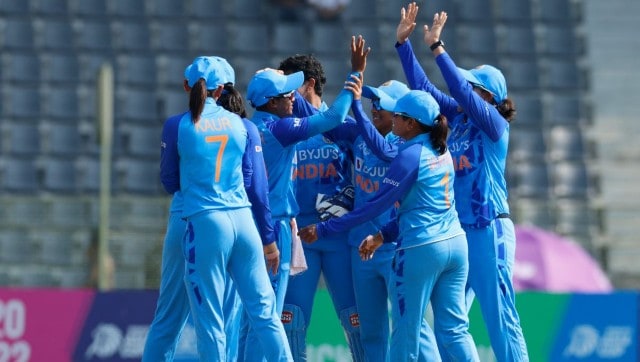BCCI’s ‘pay equity policy’ a laudable decision, but better and more contracts is the real deal – Firstcricket News, Firstpost

Soon after the Board of Control for Cricket in India (BCCI) announced its ‘pay equity’ policy guaranteeing equal match fees for contracted India women cricketers same as their male counterparts, the BCCI Women Twitter handle uploaded a 20-second video clip of captain Harmanpreet Kaur hailing the “landmark” move.
The cricket board, which has stopped holding press conferences after national team selections or sending press releases explaining the decision to call up or snub a player, was quick to also send a press release on their new decision with quotes from the president, secretary and all of the top brass telling us how we are entering a “new era” in Indian cricket.
The BCCI is well aware of the changing times and the rarity of its decision and hence decided to collect some positive PR. As they would have wanted, the pay equity policy was lapped up by the national media and the cricket board had its headlines and prominent spaces on the news pages. It matters little how the players or former cricketers have responded. Their enthusiasm is justified. After all, they have been the victim of discrimination.
This is a historic decision for women’s cricket in India! The pay equity policy along with the WIPL next year, we are ushering into a new era for women’s cricket in India. Thank you @JayShah Sir & the @BCCI for making this happen. Really happy today. https://t.co/xOwWAwsxfz
— Mithali Raj (@M_Raj03) October 27, 2022
It’s important how we treat this new policy. Is it a step in the right direction to eradicate the gender divide in Indian cricket? Of course, a big one in that context. But context is also important to accurately asses how ‘historic’ the move is.
Essentially, more than a historic move, it’s a better late than never decision.
BCCI trails smaller boards in working for women cricketers
In fact smaller and obviously less rich boards have taken a big lead over BCCI when it comes to women’s cricket. Earlier this year, New Zealand Cricket (NZC) combined the men’s and women’s professional environments in one agreement. The women’s national team players and domestic women’s players in New Zealand are receiving the same match fee as men from 1 August.
A day after BCCI’s big announcement, it was informed that 80 women’s domestic contracts will be handed over in England from February next year. The England and Wales Cricket Board (ECB) is set to have close to 100 professional cricketers. A domestic contract is not a reality in Indian cricket.
Good news: ECB have poured another £3.5m into women’s cricket. They’ve invested in salaries for the regions, which will mean there will be 80 women’s domestic contracts from February, and close to 100 professional women’s cricketers (av salary £25k) in the country.
— Will Macpherson (@willis_macp) October 28, 2022
No doubt, the BCCI’s historic move pales in comparison to what is going around in the world of cricket.
Even within the Indian central contract system, the gender disparity is still stark and reprehensible.
Central contracts are offered each year to a group of top players (both male and female) who have been picked to play for the national sides. The contracts are divided into different grades with different remuneration structures. Which player will belong to which grade is determined by their performances and utility to the team.
Central contracts guarantee payment of a certain amount even if a player misses matches due to injury or other reasons. While a match fee is only paid to players for participating in a game.
Coming to the stinking disparity. Skipper Harmanpreet who features in the top grade of central contracts for women cricketers earns less than what the men cricketers in the fourth grade make.
Central contracts for the Indian women’s cricket team for 2021-22:
Grade A: INR 50 lakh
Grade B: INR 30 lakh
Grade C: INR 10 lakh
Central contracts for the Indian men’s cricket team for 2021-22:
Grade A+: INR 7 crore
Grades A: INR 5 crore
Grade B: INR 3 crore
Grade C: INR 1 crore
Also, the increase in match fees is only significant if the matches for women’s team increases at the same pace. The women’s team plays a lot fewer matches than the Men in Blue and till the time this inconsistency in scheduling remains, the pay equity policy would mean little.
Real significance
With few matches and intense competition within the team, the number of real beneficiaries of the match fees hike would be limited in any case.
To make a bigger impact, bolder decisions are required. The stark disparity in the central contracts is what the BCCI must address soon. The world’s richest board should also look to extend the safety net to domestic cricketers.
While increasing match fees has its benefits, the main issue is financial security. If the board is really serious about making women’s cricket a viable career option, then they need to guarantee adequate money to the players. Else the players will continue to juggle playing with jobs, which in any case is getting fewer for professional cricketers.
The real significance of the pay equity policy is that BCCI has accepted that women cricketers deserve equal money for putting in equal effort. If BCCI can buck the market economics in its decision regarding match fees, there’s no reason why economics must decide the contract offerings.
Read all the Latest News, Trending News, Cricket News, Bollywood News, India News and Entertainment News here. Follow us on Facebook, Twitter and Instagram.
For all the latest Sports News Click Here
For the latest news and updates, follow us on Google News.

